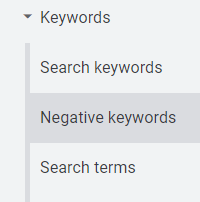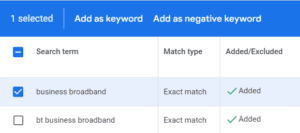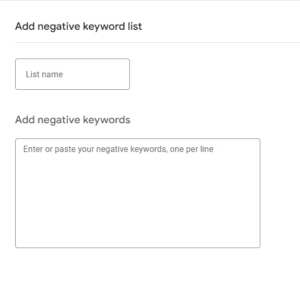
Negative keywords: how to use them in Google Ads

In an ideal PPC world, the keywords you bid on would match our ads with the most relevant traffic and generate high-intent, relevant clicks that convert into leads or sales. However, just like anything in life, it’s not quite that simple.
A solid structure including relevant keywords, ads, ad groups and landing pages is essential to succeed in paid search. Determining this will allow you to find potential users who are searching for your products or services. However, this can come at a cost as it’s equally important to identify keywords or search queries that aren’t relevant to your offerings. A lot of advertisers can get frustrated as they’re paying for clicks that will never convert or deliver a return on ROI.
So, how can you avoid falling into this pitfall of wasting spend? Negative keywords.
In this blog, you’ll learn what they are, their different match types and how to implement them.
And if you need expert PPC consultants on hand, get in touch today!
What are Negative Keywords?
Negative Keywords are an extremely useful tool in Google Ads that allows you to exclude keywords that are unrelated to your services or products. In turn, efficiently spend your budget on clicks that are more likely to convert as your ads are being shown to interested users.
Negative keywords can be implemented at a campaign, keyword or ad group level and come in different match types, just like targeted keywords that you bid on. Therefore, in order for negative keywords to be successful you must understand each match type if you want to maximise the usefulness of negative keywords.
To maximise your CTR (click-through rate) and conversion rate you need to understand exactly who you want your ads to target. You can then begin to target relevant keywords and refine any irrelevant search queries via negative keywords, increasing relevance.
Negative Keyword: Match Types
Negative Broad Match
Broad-match negative keywords prevent your ads from appearing for searches if the search contains any word of that negative term, in any order. For example, if your broad match negative keyword is ‘black shoes’ your ad won’t appear for searches similar to the phrase such as ‘black leather shoes’ or reverse order ‘shoes black’’.
Broad match negatives can limit your reach significantly, therefore only use broad match if you’re certain you don’t want your ad to show for anything related to the negative keyword.
Negative Phrase Match
Phrase match negative keywords are a safer option as they don’t limit your search query as much as broad match. It also narrows down your ad visibility to who you want your ad to be shown to.
With phrase match negatives your ads are excluded from users searching for that exact keyword phrase including any words included before or after. For example, if your negative phrase match keyword is ‘nail salon shop’, your ad won’t appear for searches such as ‘nail salon shop near me’ or ‘acrylic nail salon shop’. However, your ad could still appear for searches such as ‘hair and salon shop’ or ‘hair salon’.
Negative Exact Match
Negative exact match keywords prevent your ads from appearing if the search contains the exact keyword term as it is, with no variations. However, your ad may still appear if it includes the keyword term with additional words. For example, if your negative exact keyword is ‘beach holidays’ your ad will be excluded from users’ search ‘beach holidays’.
Exact match negatives give you more flexibility, but be careful as they aren’t as restrictive as alternative match types and could lead to your ads being shown to the wrong audience.
How To Add Negative Keywords
So how do you add negative keywords to your account? Firstly, you’ll need to navigate your way over to the grey sidebar on the left-hand side of your Google Ads account and hit the ‘keywords’ tab. Here you’ll be able to find the targeted keywords you are bidding on and under ‘search terms’ the queries that triggered them.

(Source: Google Ads)
Let’s say that you don’t want your ads to serve for the search query ‘business broadband’. Once you’ve selected the search query, a blue bar will appear at the top of the search queries and here you can then select ‘add as a negative keyword’.

(Source: Google Ads)
From here you will then need to assign your preferred match type for your search query (broad, phrase or exact) and hit the save button. Once you’ve hit save all negative keywords will be live.
Creating Negative Keyword Lists
For certain campaigns, you may only want to apply a particular set of negative keywords or you may just want to gain more control over what negative keywords you’re implementing across your account. In this case, negative keyword lists are your saving grace. Negative keyword lists can be found and built under the ‘shared library’ column under the ‘tools and settings’ icon in the top right-hand corner of Google Ads UI.

(Source: Google Ads)
From here, click the blue plus button and here you will be able to name your keyword list and include all keywords you want to negate – be mindful of what match types you implement.

(Source: Google Ads)
Once you’ve hit save, further down the page you will see an option ‘apply to campaigns’, if you select this you can then select the appropriate campaigns you’d like to apply this list to. You can also add negative keywords to these lists when you’re filtering through your search terms (as shown above).
FAQs
What are the benefits of negative keywords?
There are many benefits to using negative keywords, but the main one is saving money (which we all want to do)! Implementing negative keywords ensures you aren’t paying for clicks that are irrelevant and increases your relevancy as your ads are serving to interested users. Increasing your relevance also means that your click through rate (CTR) will increase.
Is it best to add plural or singular negative keywords?
The answer is both. It’s best to have a mixture of plural and singular to avoid showing up for either version – the more specific you can be the better. For example, if you want to add ‘house’ as a negative keyword, you’d also want to add ‘houses’.


